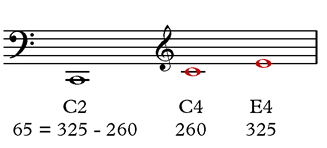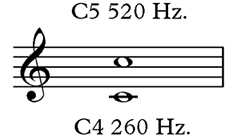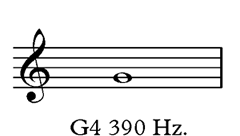What do you hear?
José Rodríguez Alvira
This phenomenon has been known for centuries. The Italian violinist Giuseppe Tartini (1692-1770) spoke of the terzo souno or third tone, which is created from two tones. The third tone can help tune the two original tones. A major third is perfectly tuned when the note produced is two octaves lower than the bass note. Any change in the tuning of the upper tone will be reflected in the frequency of the third tone:

Organ constructors use of this phenomenon to produce low-pitched sounds with smaller pipes. Two pipes tuned to a perfect fifth will generate a sound one octave lower than the lowest sounding pipe.
The fact that our auditory system is able to reconstruct the lower harmonics from the higher harmonics explains why we can listen to music on sound equipment that is limited in its ability to reproduce low sounds.
Tartini Effect
Finally, let's experiment with the Tartini effect. We suggest you use headphones. Be careful that the volume is not too high!
- Play C4/C5.
- Add the G4, do you hear a lower note? This is Tartini's terzo suono a C3. Continue with the next step, even if you do not hear the C3...
- Change the tuning of the G4 using the + and - buttons. Changing the tuning of the G4 will affect the generated C3 and produce a beat. If you did not hear the C3 in the previous step, you may now notice that when the G4 tuning is changed, another lower note also changes. You may also notice that the beat seems to be produced by the C3. If you do not hear the beat, carefully increase the volume.

The G4 is a perfect fifth above the C4 and is tuned using the size of the fifth of the harmonic series: 260 x 1.5 = 390. The perfect fifth of the equal temperament system - which is in common use today - is 2 cents smaller than the fifth of the harmonic series.
If you would like to know why the equal temperament has smaller fifths, follow this link to read about tuning systems...
Reference and additional information:
- Benade, Arthur H. 1990. Fundamentals of Musical Acoustics, 2nd edition. Dover Publications, New York.
- The Harmonic Series. teoria.com.
- 2,500 years of musical temperaments. teoria.com.
- Piano tuning. Wikipedia.
- Beat. Wikipedia.
- Cent. Wikipedia.
- Combination Tone. Wikipedia.
- Missing fundamental. Wikipedia.
- Harmonic Series. Wikipedia.
© 2017 José Rodríguez Alvira. Published by teoria.com

